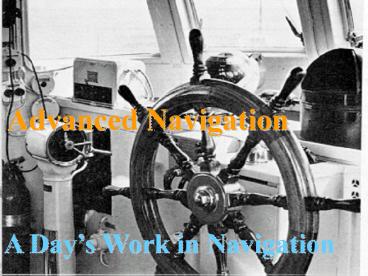Advanced Navigation - PowerPoint PPT Presentation
1 / 20
Title:
Advanced Navigation
Description:
1. Identify ideal times to observe various. celestial bodies and the accuracy of ... Course lines: Bodies observed abeam can be used to check ship's course. ... – PowerPoint PPT presentation
Number of Views:72
Avg rating:3.0/5.0
Title: Advanced Navigation
1
Advanced Navigation
A Days Work in Navigation
2
Objectives
1. Identify ideal times to observe various
celestial bodies and the accuracy of
information they provide. 2. Identify the
minimum days work in celestial
navigation. 3. List the major categories of
information contained in the COs Night
Orders.
3
Nav at Sea
Differences - - Fix intervals increase. - Less
danger of grounding - Courses speeds
maintained for longer durations - Celestial
Navigation can be used to establish position
and check the compass.
4
Nav at Sea
Celestial Observations - - Altitudes 15 - 65
above the horizon typically produces best
LOPs - Order East to West - Venus Used to
generate a fix with sun moon - Sun Can
obtain sun lines latitude
5
Nav at Sea
Celestial Observations - - Moon Can be used to
generate a fix - Polaris Can be used to
produce a latitude LOP - Stars Best
observed between nautical twilight and
civil twilight. - Speed lines Bodies observed
ahead or astern can be used to check
ships speed or advance
6
Nav at Sea
Celestial Observations - - Course lines Bodies
observed abeam can be used to check ships
course. - Speed lines Bodies observed ahead or
astern can be used to check ships speed or
advance.
7
Time
Celestial Observations - In order to perform
celestial calculations, it is important
to know the exact time. - Check time pieces
against the continuous radio time signals
- GPS receiver
8
Captains Night Orders
COs Night Orders - Written by the
Navigator. Contain all the navigation
instructions necessary for the OOD to safely
navigate the ship during the night. Celestial
info included - Sunrise / sunset - Civil /
Nautical twilight - Moonrise / moonset
9
Six Rules of DR
10
Plot a DR PositionEvery Hour on the Hour
0900
1000
1100
11
Plot a DR Position at Every Course Change
29
20
c-090
c-125
c-080
24
12
Plot a DR Position at Every Speed Change
21
27
15
s-10
s-15
s-5
13
Plot a DR Position for Every Line of Position
(LOP)
Tank
26
0826
14
Plot a DR Position for Every Fix or Running Fix
46
37
0937
R-fix
15
A new Course Line shall be drawn with Every Fix
or Running Fix
c-075 s-15
0937
R-fix
16
Routine Day
Celestial Observations - During clear weather,
the following sequence is followed - Post
evening stars Prepare COs Night Orders
- Middle of night Compute time of twilight
and prepare list of favorable stars - Morning
twilight Observe altitudes of selected
stars
17
Routine Day
Celestial Observations - During clear weather,
the following sequence is followed - Sunrise
Compute observe amplitude of sun -
Mid-morning Observe sun (Venus moon if
possible) - Noon Observe altitude of the sun
18
Routine Day
Celestial Observations - During clear weather,
the following sequence is followed -
Mid-afternoon Observe sun (Venus moon if
possible) and prepare list of favorable
stars - Sunset Compute and observe amplitude
of sun - Evening twilight Observe
altitude of the selected stars
19
Questions?
20
Compliments of Curtis Senior High School NJROTC































